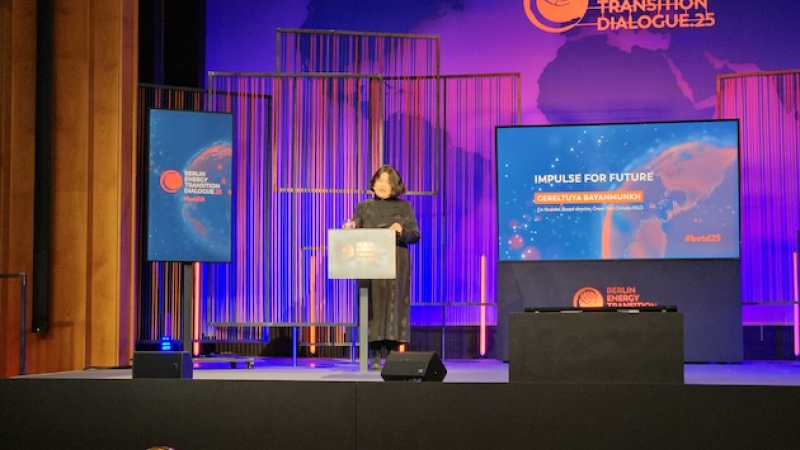- Trump considering military options on Greenland; Europe rejects |
- Fertiliser crunch threatens Kushtia’s onion boom despite high prices |
- Security Council Divided on United States' Venezuela Action |
- Over 1.53m voters register for postal balloting: Shafiqul Alam |
Mongolia’s Just Transition Must Include Its Nomadic Herders

Gereltuya Bayanmukh speaks about her motivations to become involved in climate activism.
Youth activist Gereltuya Bayanmukh continues to reflect on the moments from her childhood that sparked her passion for climate activism. As a young girl, she would visit her grandparents in a village 20 kilometres south of the Russia-Mongolia border. She fondly remembers how the nomadic families in their traditional gers powered their homes with solar energy.
“I remember seeing my neighbours using a solar panel and a battery to store power. They had lights and watched TV using solar energy. Nowadays, they even have refrigerators,” she recalls.
At the time, she believed the herders had consciously chosen a sustainable lifestyle in response to the growing climate crisis by switching to renewable energy. This impression inspired her to become a climate activist. However, she later discovered that the solar panels had been partially subsidised by the government as part of a national initiative to supply 100,000 nomadic households with solar systems.
What she had thought was a community-driven shift turned out to be a nationwide renewable energy programme launched by the Mongolian government. Known as the National 100,000 Solar Ger Electricity Programme, it was introduced in 2000 to provide portable solar home systems that fit the nomadic way of life.
Before 2000, most nomadic herders had little or no access to electricity. By 2005, over 30,000 herder families had received systems, funded by various donor countries. However, the programme began to falter. A midterm audit in 2006 revealed mismanagement, including poor distribution controls, units delivered to non-residents, unmet targets, misuse of funds, and loan repayment failures.
The third phase of the programme, which ran from 2006 to 2012, was implemented more effectively with support from international partners such as the World Bank. Even so, Gereltuya's optimism was dampened when she read the audit findings. What began as a promising transition to renewable energy was only successfully completed due to foreign support, not government efficiency.
Now, as the co-founder and board director of the NGO Green Dot Climate, Gereltuya is focused on educating and empowering youth to become climate-conscious citizens. Her organisation has reached over half a million Mongolians, including nomads, raising awareness and equipping young people with practical climate action skills.
Speaking at the 2023 One Young World Summit, she highlighted that Green Dot’s youth community had logged over 100,000 individual climate actions, saved more than 700,000 kilograms of CO₂, conserved 25 million litres of water, and reduced electricity usage by 80,000 kilowatt-hours. Their next goal is to reach one million actions and launch at least 50 collaborative climate projects across Mongolia.
Despite Mongolia’s commitment to a 30 percent share of renewable energy in its installed capacity by 2030, the country remains heavily dependent on coal, which accounts for 90 percent of its energy production. The energy sector also represents nearly 45 percent of Mongolia’s total greenhouse gas emissions.
Green Dot Climate has been mapping Mongolia’s energy system and found that only 7 percent of the total installed energy comes from renewables. Most electricity is generated by combined heat and power plants and supplemented by imports from Russia and China. About 200,000 households, likely nomadic or semi-nomadic, are not reflected in the central energy grid data.
Although Mongolia has pledged to reduce its emissions by 22.7 percent by 2030—and possibly up to 44.9 percent with additional mitigation—the reality shows a backslide. Instead of decarbonising its coal-based economy, the country has shifted focus to carbon sinks and sequestration, suggesting a lack of political will and policy effectiveness.
Green Dot Climate has been gathering youth feedback for inclusion in Mongolia’s next climate commitment, NDC 3.0, expected ahead of COP30. Among the recommendations are calls to upgrade outdated solar systems for off-grid families, remove fossil fuel projects from the development pipeline, improve electricity infrastructure, utilise existing capacity, and increase investment in renewable energy generation to replace coal.
According to the World Bank, electricity tariffs in Mongolia were 40 percent below cost-recovery levels, and subsidies amounted to 3.5 percent of GDP in 2022. This discourages energy efficiency and renewable investment. Without serious reforms, the country may fall further behind on its clean energy commitments.
Gereltuya concludes that Mongolia’s green future depends not just on technology or policies, but on better governance, accountability, and genuine inclusion—especially of its nomadic people who were once the pioneers of solar living.

